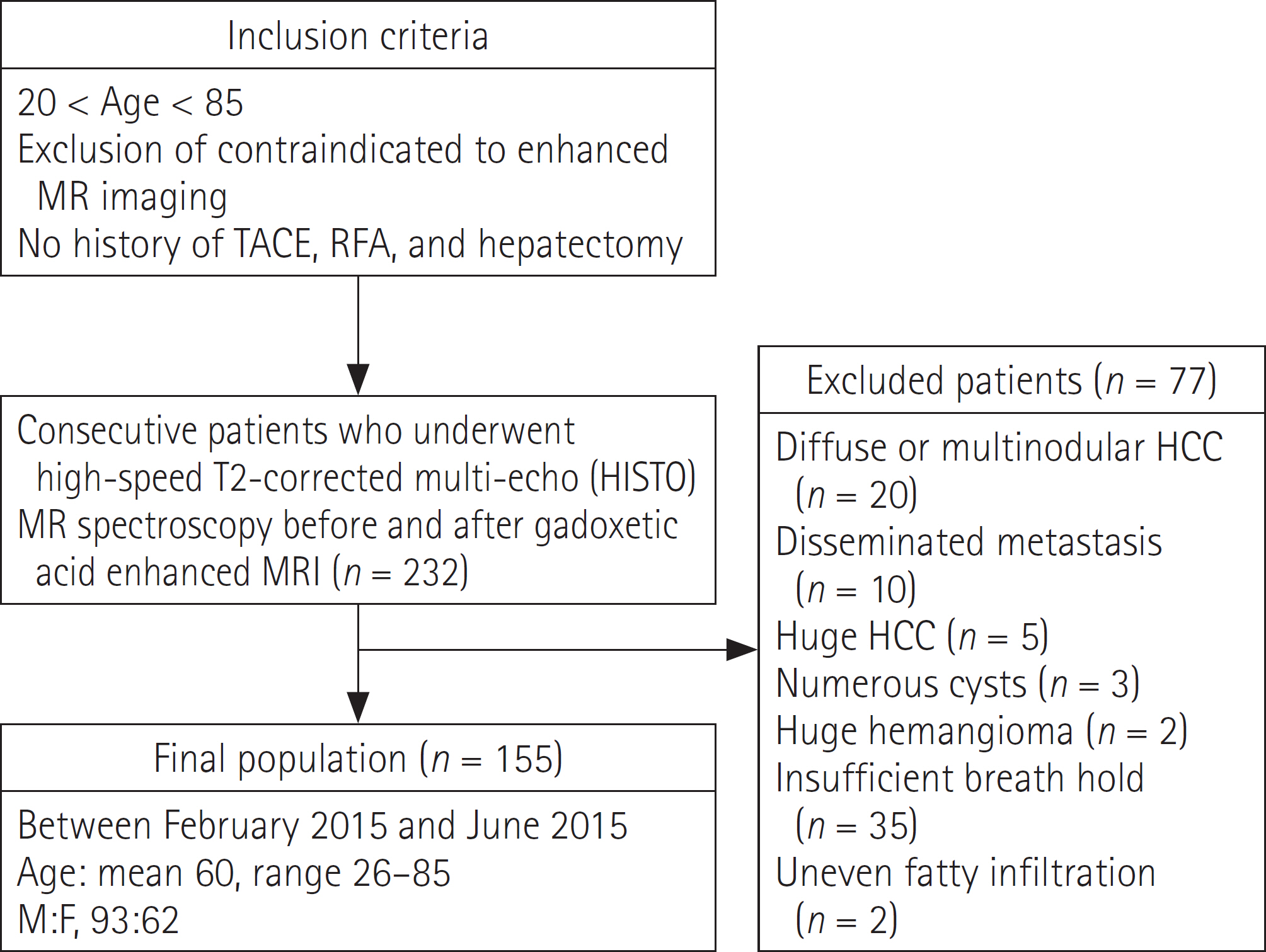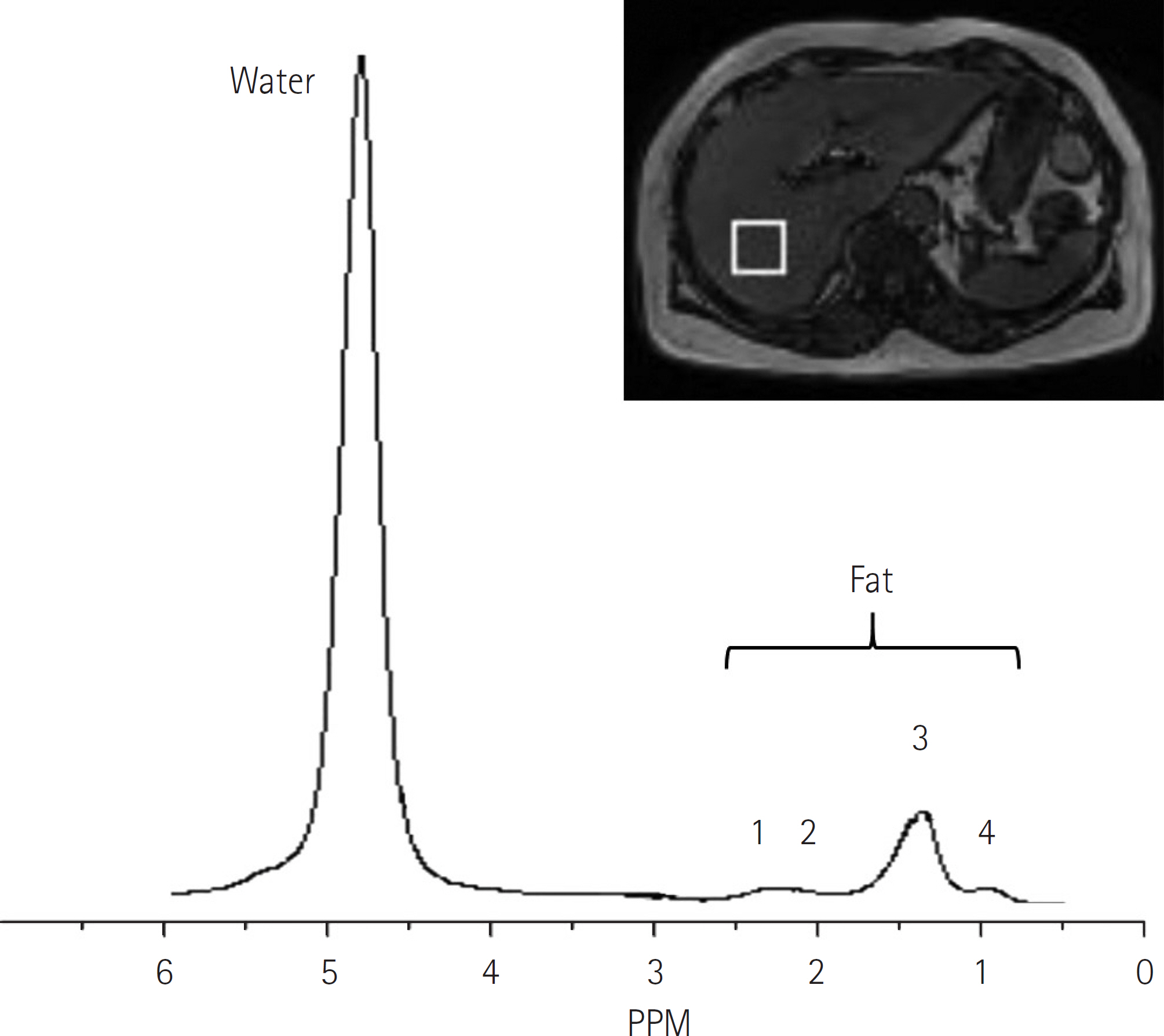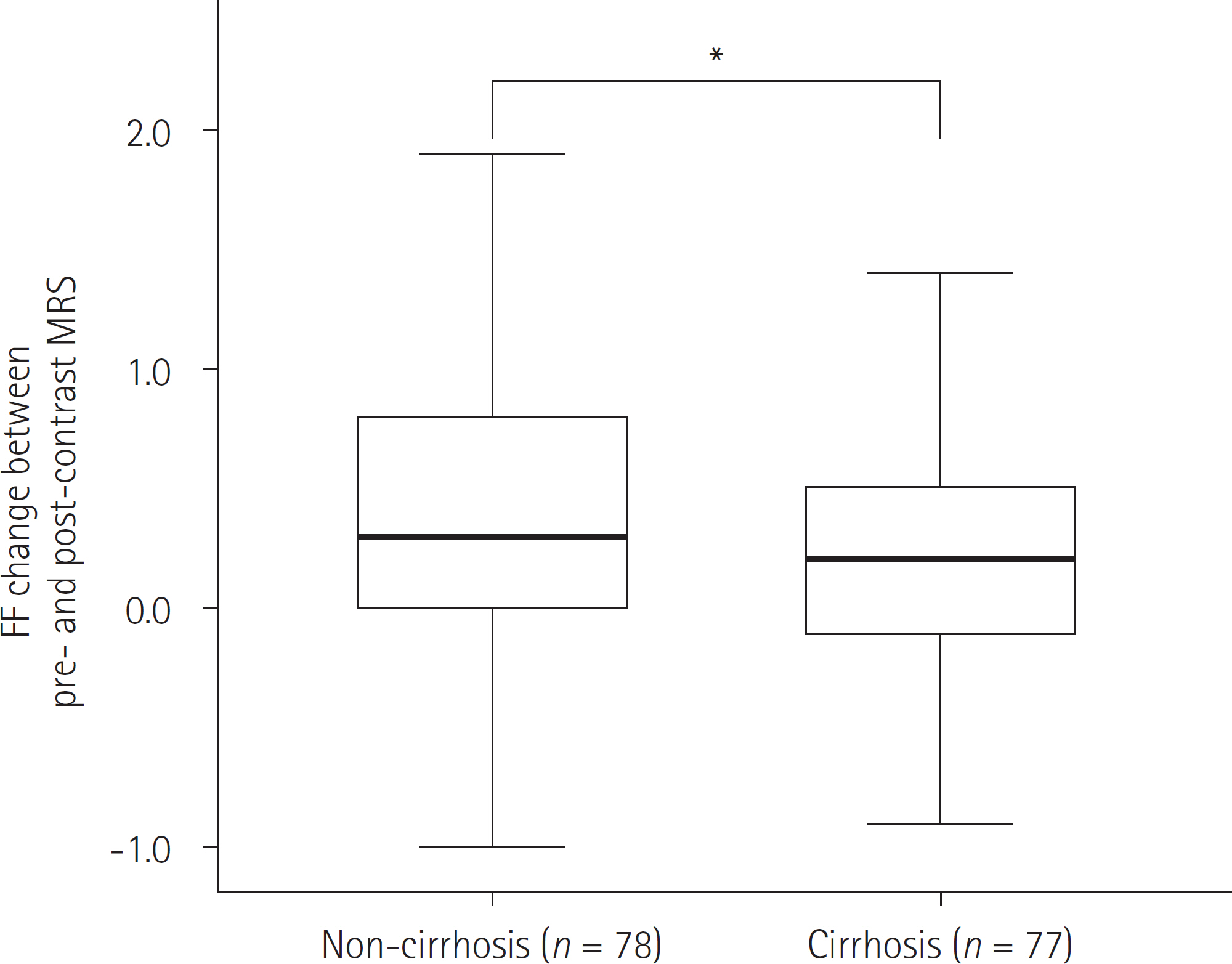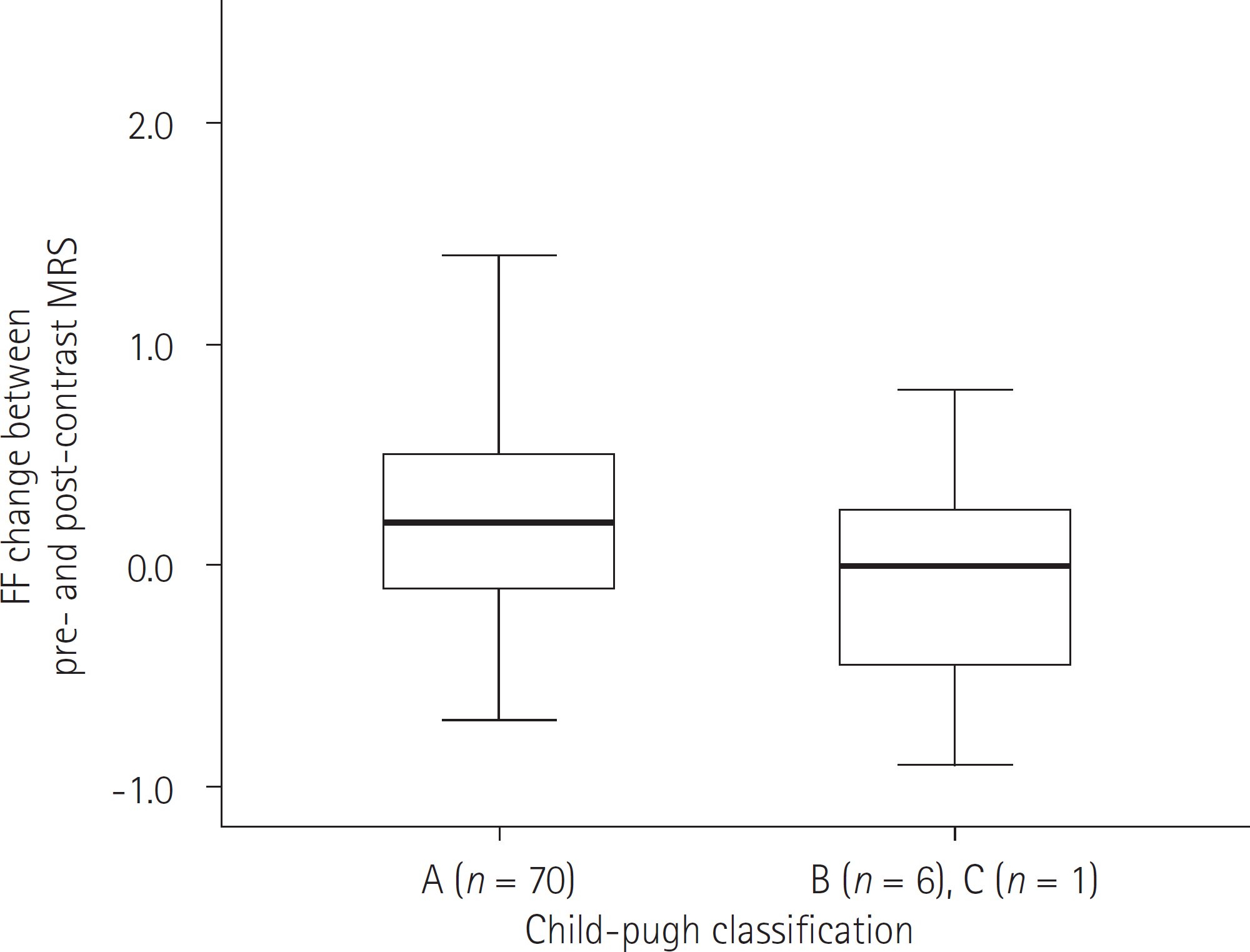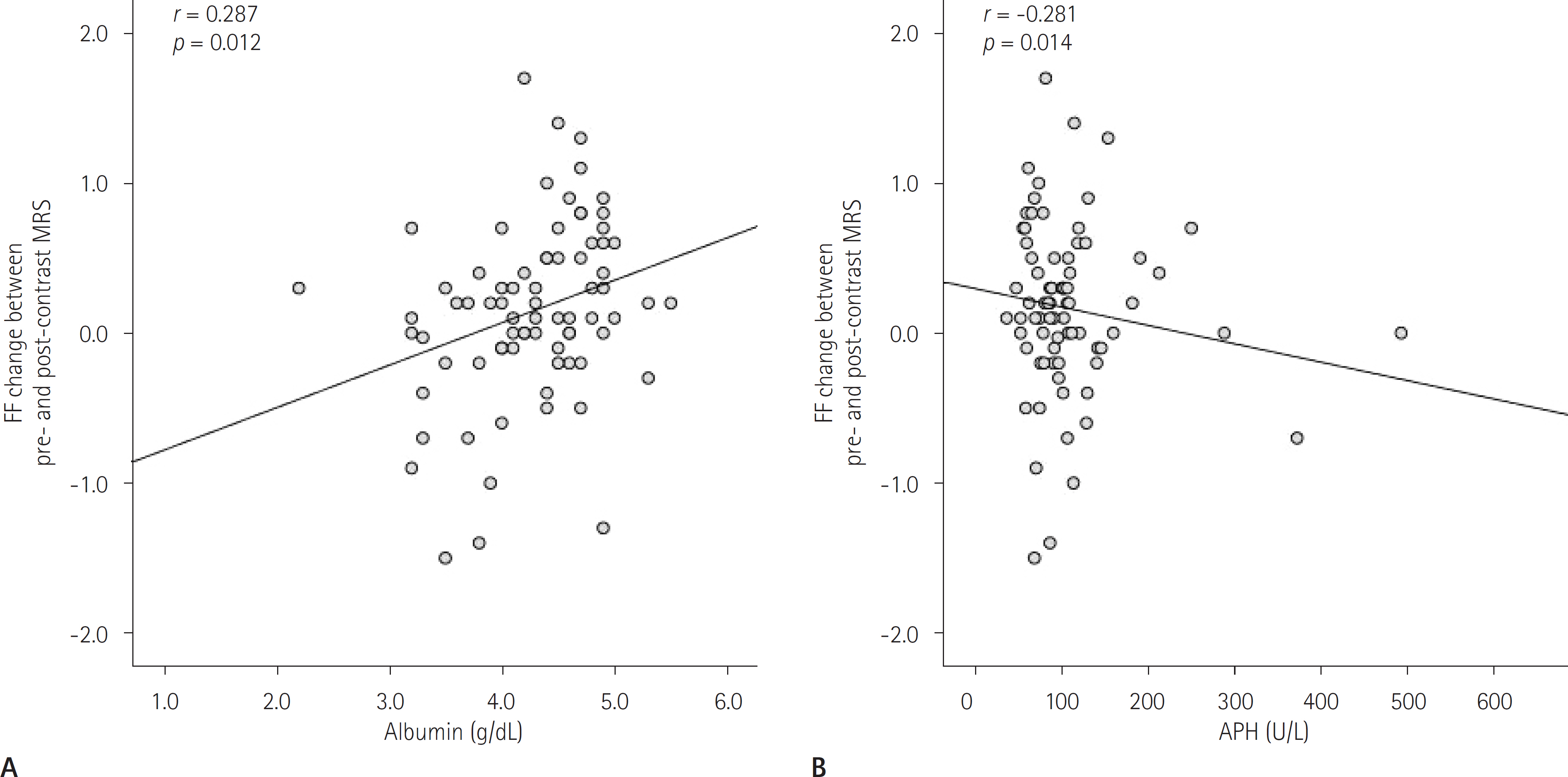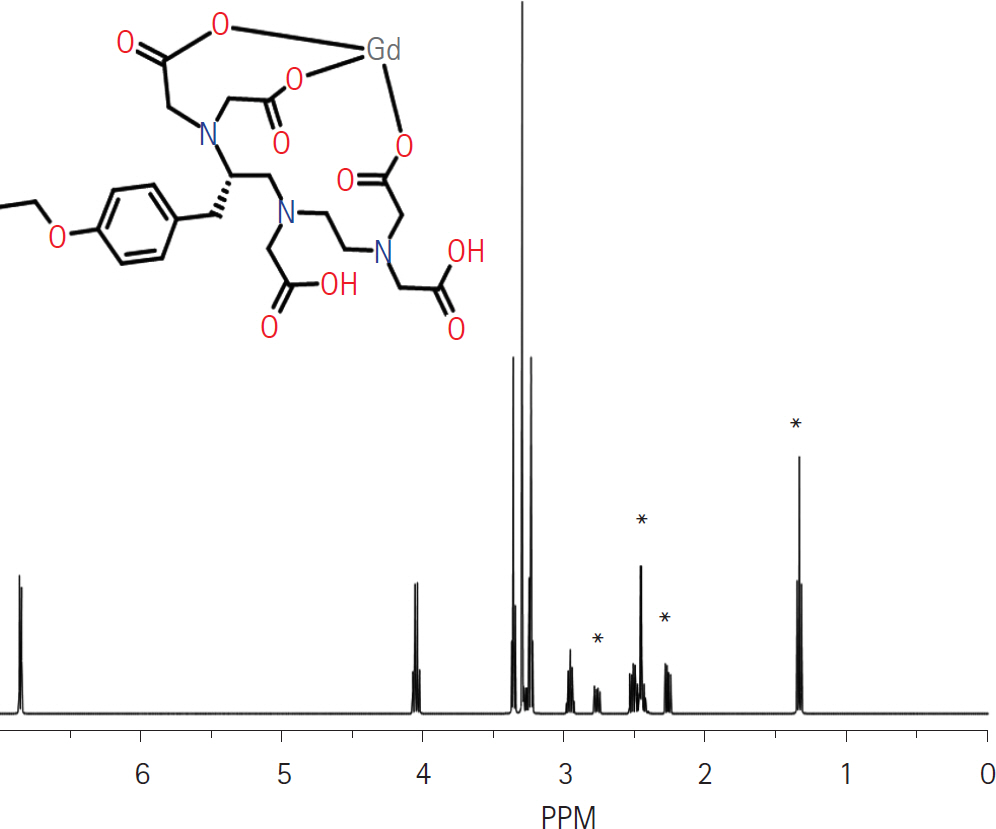J Korean Soc Radiol.
2017 Apr;76(4):237-244. 10.3348/jksr.2017.76.4.237.
Effect of Gadoxetic Acid on Quantification of Hepatic Steatosis Using Magnetic Resonance Spectroscopy: A Prospective Study
- Affiliations
-
- 1Department of Radiology, Chonnam National University Hwasun Hospital, Hwasun, Korea. yjeong@jnu.ac.kr
- 2Department of Radiology, Chonnam National University Hospital, Gwangju, Korea.
- KMID: 2373959
- DOI: http://doi.org/10.3348/jksr.2017.76.4.237
Abstract
- PURPOSE
We prospectively evaluated whether gadoxetic acid (Gd-EOB-DTPA) administration for liver magnetic resonance (MR) imaging affects the quantification of hepatic steatosis using MR spectroscopy (MRS).
MATERIALS AND METHODS
A total of 155 patients were included, who underwent gadoxetic acid-enhanced liver MR imaging and MRS during a 5-month period. Fast breath-hold high-speed T2-corrected multi-echo MRS was used before, and 20 min after, gadoxetic acid injection. The same location was maintained in the pre-contrast and post-contrast MRS. Changes in the fat fraction (FF) were compared between the pre- and post-contrast MRS using a paired t-test. The change in FF between cirrhotic and non-cirrhotic patients was compared using an independent t-test. In cirrhotic patients, the correlation between FF change and biochemical marker using Pearson's correlation test, was evaluated.
RESULTS
The mean FF in the post-contrast MRS (5.05 ± 5.26%) was significantly higher than in the pre-contrast MRS (4.77 ± 0.57%) (p < 0.000). The FF change between pre-contrast and post-contrast MRS was significantly higher in non-cirrhotic patients (0.41 ± 0.77%) than in cirrhotic patients (0.14 ± 0.59) (p = 0.010). Albumin and alkaline phosphatase shows weak correlation with FF change (both p < 0.02).
CONCLUSION
Gadoxetic acid affects the quantification of hepatic steatosis by MRS. Hence, MRS should be performed before gadoxetic acid injection, particularly in non-cirrhotic patients.
MeSH Terms
Figure
Reference
-
1. Angulo P. Nonalcoholic fatty liver disease. N Engl J Med. 2002; 346:1221–1231.
Article2. Browning JD, Szczepaniak LS, Dobbins R, Nuremberg P, Hor-ton JD, Cohen JC, et al. Prevalence of hepatic steatosis in an urban population in the United States: impact of ethnicity. Hepatology. 2004; 40:1387–1395.
Article3. Farrell GC, Larter CZ. Nonalcoholic fatty liver disease: from steatosis to cirrhosis. Hepatology. 2006; 43(2 Suppl 1):S99–S112.
Article4. Ong JP, Younossi ZM. Epidemiology and natural history of NAFLD and NASH. Clin Liver Dis. 2007; 11:1–16. vii.
Article5. Szczepaniak LS, Nurenberg P, Leonard D, Browning JD, Re-ingold JS, Grundy S, et al. Magnetic resonance spectroscopy to measure hepatic triglyceride content: prevalence of hepatic steatosis in the general population. Am J Physiol En-docrinol Metab. 2005; 288:E462–E468.
Article6. Marchesini G, Brizi M, Morselli-Labate AM, Bianchi G, Bu-gianesi E, McCullough AJ, et al. Association of nonalcoholic fatty liver disease with insulin resistance. Am J Med. 1999; 107:450–455.
Article7. Mehta SR, Thomas EL, Bell JD, Johnston DG, Taylor-Robin-son SD. Noninvasive means of measuring hepatic fat content. World J Gastroenterol. 2008; 14:3476–3483.
Article8. Syn WK, Nightingale P, Bateman JM. Nonalcoholic fatty liver disease in a district general hospital: clinical presen-tation and risk factors. Hepatol Int. 2008; 2:190–195.
Article9. Wieckowska A, Feldstein AE. Nonalcoholic fatty liver disease in the pediatric population: a review. Curr Opin Pedi-atr. 2005; 17:636–641.
Article10. van Werven JR, Hoogduin JM, Nederveen AJ, van Vliet AA, Wajs E, Vandenberk P, et al. Reproducibility of 3.0 Tesla magnetic resonance spectroscopy for measuring hepatic fat content. J Magn Reson Imaging. 2009; 30:444–448.
Article11. Roldan-Valadez E, Favila R, Martínez-López M, Uribe M, Ríos C, Méndez-Sánchez N. In vivo 3T spectroscopic quantification of liver fat content in nonalcoholic fatty liver disease: Correlation with biochemical method and morphom-etry. J Hepatol. 2010; 53:732–737.
Article12. Lee SS, Park SH. Radiologic evaluation of nonalcoholic fatty liver disease. World J Gastroenterol. 2014; 20:7392–7402.
Article13. Wu CH, Ho MC, Jeng YM, Hsu CY, Liang PC, Hu RH, et al. Quantification of hepatic steatosis: a comparison of the accuracy among multiple magnetic resonance techniques. J Gastroenterol Hepatol. 2014; 29:807–813.
Article14. Bohte AE, van Werven JR, Bipat S, Stoker J. The diagnostic accuracy of US, CT, MRI and 1H-MRS for the evaluation of hepatic steatosis compared with liver biopsy: a meta-analysis. Eur Radiol. 2011; 21:87–97.
Article15. Frydrychowicz A, Lubner MG, Brown JJ, Merkle EM, Nagle SK, Rofsky NM, et al. Hepatobiliary MR imaging with gado-linium-based contrast agents. J Magn Reson Imaging. 2012; 35:492–511.
Article16. Jeong WK, Kim YK, Song KD, Choi D, Lim HK. The MR imaging diagnosis of liver diseases using gadoxetic acid: empha-sis on hepatobiliary phase. Clin Mol Hepatol. 2013; 19:360–306.
Article17. Hamm B, Staks T, Mühler A, Bollow M, Taupitz M, Frenzel T, et al. Phase I clinical evaluation of Gd-EOB-DTPA as a hepatobiliary MR contrast agent: safety, pharmacokinet-ics, and MR imaging. Radiology. 1995; 195:785–792.
Article18. Park YS, Lee CH, Kim JH, Kim BH, Kim JH, Kim KA, et al. Effect of Gd-EOB-DTPA on hepatic fat quantification using high-speed T2-corrected multi-echo acquisition in (1)H MR spectroscopy. Magn Reson Imaging. 2014; 32:886–890.
Article19. Hamilton G, Yokoo T, Bydder M, Cruite I, Schroeder ME, Sirlin CB, et al. In vivo characterization of the liver fat ¹H MR spectrum. NMR Biomed. 2011; 24:784–790.20. Kamath PS, Wiesner RH, Malinchoc M, Kremers W, Therneau TM, Kosberg CL, et al. A model to predict survival in patients with end-stage liver disease. Hepatology. 2001; 33:464–470.
Article21. van Montfoort JE, Stieger B, Meijer DK, Weinmann HJ, Mei-er PJ, Fattinger KE. Hepatic uptake of the magnetic resonance imaging contrast agent gadoxetate by the organic anion transporting polypeptide Oatp1. J Pharmacol Exp Ther. 1999; 290:153–157.22. Feier D, Balassy C, Bastati N, Stift J, Badea R, Ba-Ssalamah A. Liver fibrosis: histopathologic and biochemical influences on diagnostic efficacy of hepatobiliary contrast-enhanced MR imaging in staging. Radiology. 2013; 269:460–468.
Article23. Tamada T, Ito K, Higaki A, Yoshida K, Kanki A, Sato T, et al. Gd-EOB-DTPA-enhanced MR imaging: evaluation of hepatic enhancement effects in normal and cirrhotic livers. Eur J Radiol. 2011; 80:e311–e316.
Article24. Kanki A, Tamada T, Higaki A, Noda Y, Tanimoto D, Sato T, et al. Hepatic parenchymal enhancement at Gd-EOB-DTPA-enhanced MR imaging: correlation with morphological grading of severity in cirrhosis and chronic hepatitis. Magn Reson Imaging. 2012; 30:356–360.
Article25. Kim HY, Choi JY, Park CH, Song MJ, Song DS, Kim CW, et al. Clinical factors predictive of insufficient liver enhancement on the hepatocyte-phase of Gd-EOB-DTPA-enhanced magnetic resonance imaging in patients with liver cirrhosis. J Gastroenterol. 2013; 48:1180–1187.
Article26. Bastati N, Feier D, Wibmer A, Traussnigg S, Balassy C, Ta-mandl D, et al. Noninvasive differentiation of simple steatosis and steatohepatitis by using gadoxetic acid-enhanced MR imaging in patients with nonalcoholic fatty liver disease: a proof-of-concept study. Radiology. 2014; 271:739–747.
Article27. van Werven JR, Marsman HA, Nederveen AJ, ten Kate FJ, van Gulik TM, Stoker J. Hepatic lipid composition analysis using 3.0-T MR spectroscopy in a steatotic rat model. Magn Reson Imaging. 2012; 30:112–121.
Article
- Full Text Links
- Actions
-
Cited
- CITED
-
- Close
- Share
- Similar articles
-
- Imaging evaluation of non-alcoholic fatty liver disease: focused on quantification
- Hepatic Angiomyolipoma Presenting as a Hyperintense Lesion During the Hepatobiliary Phase of Gadoxetic Acid Enhanced-MRI: a Case Report
- Non-invasive monitoring of hepatic steatosis via acoustic structure quantification of ultrasonography with MR spectroscopy as the reference standard
- Assessment of Hepatic Steatosis Using Ultrasound-Based Techniques: Focus on Fat Quantification
- Quantitative Evaluation of Hepatic Steatosis Using Normalized Local Variance in a Rat Model: Comparison with Histopathology as the Reference Standard

